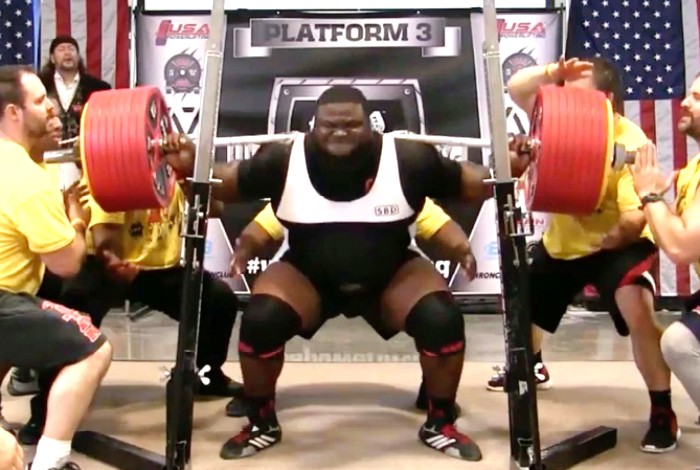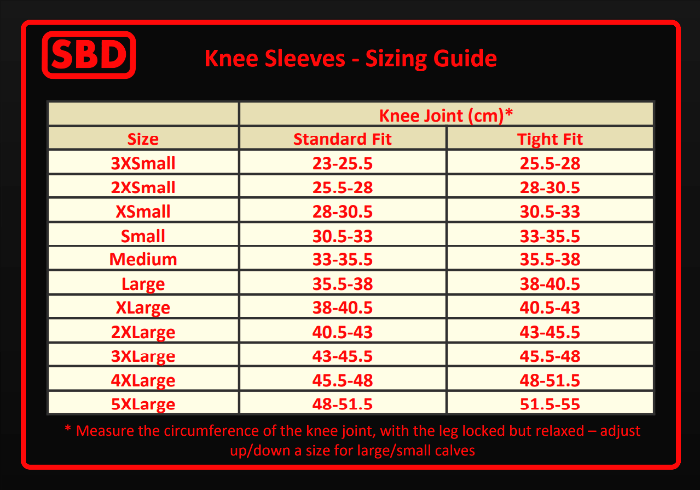

While powerlifting knee sleeves fall behind shoes and a belt in the realm of importance when it comes to powerlifting equipment (for good reason—these two items are critical for proper form and injury prevention), they are a very close third. But what makes them so important?
First off, it is important to distinguish between knee sleeves which slide up one’s calf and knee wraps—which are round tightly around the knee. While the former is allowed in raw competition, the latter is allowed exclusively in equipped competitions and “raw classic” meets (this applies to the USAPL, USPA, and other large leagues—be sure to check your exact powerlifting federation to make sure). Knee wraps add serious poundage in the range of 60-100 pounds.
Knee sleeves on the other hand are made from a neoprene material that does not wrap around the knee but is instead slid up. While they do not provide the same level of support as wraps, they are allowed in raw and unequipped powerlifting competitions. In these meets, every single lifter wears them—with very few exceptions (if you can find someone not wearing them at a raw competition, it is extremely rare). There are several reasons for this—both in training and on competition day when you step inside the powerlifting gym.
When it comes to training, sleeves are a compounding, positive training variable. In much the same way a powerlifting belt “adds up over time,” so do sleeves.
What does this mean?
As you train and follow your powerlifting program, every single seemingly-minute thing you can do to improve your performance adds up. In the case of wearing a belt, the ability to lift slightly more with each session leads to rapidly-compounding progress. While being able to lift 10-20 pounds more for a given workout is not a big deal by itself, doing this repeatedly over the course of weeks, months, and years absolutely is.
In the same way, wearing sleeves provides a small, but distinct advantage. When worn over a long period of time, this advantage starts to stack up. If your goal is to become as strong as possible and gain elite levels of strength, there is no reason not to wear them other than financial reasons.
But there are also other reasons to don them beyond just their cumulative training benefit. Three main reasons make up the majority of knee compression sleeve benefits.
Powerlifting Knee Sleeves Add Proprioception
One of the least-known benefits of sleeves, but arguably the most important is their ability to aid in proprioception. In simplest terms, proprioception is the kinesthetic awareness of where your body is in space and time. It is why gymnasts are so skilled at flying through the air, completing amazing feats of acrobatics: they have a heightened sense of their body position even when not in contact with the ground.
In the same way, sleeves allow you to become aware of your knee flexion—they tell you how deep you are in a squat. This does not happen, overnight, however. At first, wearing them will provide little benefit in this area. But, as you continue to wear them and squat with proper form and hit correct depth (hip joint travels below the knee joint), you will begin to associate the precise folding and pressure from the sleeves with this depth.
If you are training efficiently, each repetition you perform will further engrain this sensation in your mind with the end result of creating rock-solid form. When you step on the platform to compete, or even just complete the reps for your given workout, you will be able to not only squat at the proper depth but do so consistently—hitting the same exact rebound point each and every single time.
Developing your technique in this way—making each and every repetition exactly the same—is what allows for highly-optimized form. Contrast this with a lifter who performs each squat slightly different; perfecting and truly maximizing form becomes literally impossible.
Powerlifting Knee Sleeves Keep Your Knees Warm
One of the more obvious benefits to be gained from wearing sleeves is simply the heat they provide to keep the soft tissues around the knee joint warm. But how exactly does heat translate to a more “fluid” and “warmed-up” joint?
Two words: synovial fluid.
A proper warm-up includes light exercise to stimulate not just blood flow to a given area, but more importantly synovial fluid which is a thick and viscous bodily fluid responsible for serving as lubricant for your joints. In fact, one of the ways to pinpoint joint issues is to examine the lack of healthy synovial fluid.
By wearing sleeves, the knee joints are able to remain in a hyper-synovial state. In other words, there is plenty of synovial fluid present to keep the joints healthy and happy. As a powerlifter, squats will undoubtedly be a major part of your program. Improper form and poor warm-up habits are a sure-fire way to develop overuse knee injuries (lack of proper lower-body mobility is also a silent killer). One effective method in the fight against these injuries is to warm-up properly. Beyond that, however, sleeves will provide an added layer of protection to ensure your body stays healthy and strong even through the worst periods of periodization.
If you are simply looking for sleeves to keep you warm, a cheap pair on amazon with good reviews will do the trick. If you want to cash out on the other benefits of wearing sleeves though (like added poundage to your squat and total), you will need to invest in a nicer pair.
It is very important to note that if you feel knee pain without sleeves, and the pain is alleviated when you wear them, does not provide a good excuse for wearing them. You need to address the pain in your knees first and foremost. Relying on sleeves to mask patellar pain is a great way to develop tendonosis—the permanent, debilitating form of tendonitis that is treatable with physical therapy (If you are currently experiencing knee pain, begin these strengthening exercises and stretches for knee pain treatment immediately).
Powerlifting Knee Sleeves Add Weight to Your Squat and Total
The most heated topic surrounding knee sleeves was saved for last. There is much debate about whether they aid powerlifters in the form of more pounds on their squat and by extension total. There is one interesting story from the IPF World’s tournament in 2013, however, that supports the idea that they most definitely increase the amount of weight able to be lifted.
In the warm-up area, Russian coaches (three of them to be exact) were caught using plastic bags to pull overly-tight sleeves onto their athletes. It was after this occurrence that the IPF instituted the “unassisted” rule—making it clear that lifters had to put on their own sleeves without any outside assistance. While some argue sleeves provide no benefit in terms of added weight—it’s clear these Russian coaches were doing it for a reason.
Beyond just the somewhat comedic story, there are two schools of thought that agree with the notion that sleeves can add weight to your squat:
- It increases the confidence of the lifter (namely through increased proprioception) which then allows him or her to lift more on the platform
- At the bottom of the hole in a squat, the sleeve is fighting to “extend” itself to its upright position and literally provides aided knee extension which thereby provides an additional force to lift more weight
While there hasn’t been any official study conducted, it is worth noting that the type of sleeves you decide to wear will undoubtedly make this statement more or less valid. Some brands are notorious for adding extra poundage while others are viewed more so for their rehabilitative and purely-proprioceptive benefits.
SBD Knee Sleeves vs Rehband vs. Slingshot Strong Sleeves
Rehband knee sleeves are an excellent example of this. While they provide some support, they do not add nearly as much pressure—and poundage—as a tighter and thicker sleeve such as Mark Bell’s STrong sleeves or the classic SBD knee sleeves.
So if you are looking to add weight to your total with the addition of sleeves, stay away from no-name brands and Rehbands and stick with one of the thicker, more supportive options above. The debate between strong sleeves and SBD sleeves has raged for some time. However, the differences can be summed up in one word: stitching design.
The SBD sleeves are stitched in a diagonal fashion which means that the seam travels across the knee joint. The reason for this is to provide a more tapered fit. While many enjoy this added taper, some lifters find it constrictive and uncomfortable. STrong sleeves, on the other hand, are stitched in a straight line along the side which lessens the taper but avoids the problem of an uncomfortable seam.
What are the Best Powerlifting Knee Sleeves?
As with most powerlifting items, it is highly recommended that each individual tries out the different options to select what works best for him or her. With that said, if you plan on competing in the USAPL or other IPF affiliates (or the IPF itself if you are one of the few truly elite powerlifting athletes) you should stick with SBD as they are approved. Some USAPL meets will rarely allow STrong sleeves, but this is done almost exclusively at the local and state level. Regional and National events abide by IPF standards. Lastly, SBD sleeves maximize the allowed dimensions of the IPF rulebook—they make them as big as it legally allowed.
Beyond just the brand, however, if you plan to get added poundage out of wearing them, make sure to buy 1-2 sizes smaller than your “normal” size. While it will be difficult to get them on at first, they will provide much, much more support. Many top lifters are known for carrying different sizes with them—training with a larger pair and swapping them out for a smaller pair on meet day to take advantage of the increased pressure provided.
Another common technique is to use a less-supportive sleeve such as those made by Rehband, and then busting out the stiff SBD or Mark Bell sleeves for your toughest sets or competition.
If matching is important to you, however, consider checking out Titan sleeves as they come in a wide assortment of colors.
How to Measure for Knee Sleeves
Luckily, SBD provides both a standard and a “tight” fit guide to help you choose (note that some lifters will go even tighter than recommended—it comes down to how tight you are willing and able to wear them):

How to Put on Knee Sleeves
Putting on knee sleeves for the first time can be difficult. What seems like an easy task is made infinitely harder by the fact that the sleeves will (should) be very tight. With that said, however, there is one well-known technique to get them on easily and efficiently.
- Pull the sleeve onto your calf as if you were putting on tube socks
- Fold the bottom part of the sleeve up onto itself
- Place your fingers underneath the fold and use that “ledge” created to pull up the sleeve onto your knee
- Adjust the top of the sleeve and un-fold the bottom part
Some people also like to fold the top of the sleeve down as well to make it easier—but this is not necessary. If the above steps have left you confused, don’t worry—it’s a common thing to be confused about. Watch the video below by Brandon Campbell to fully understand the concept.
Note that the sleeves should fit very snug around your knees. If they are loose, return them for a smaller size.
